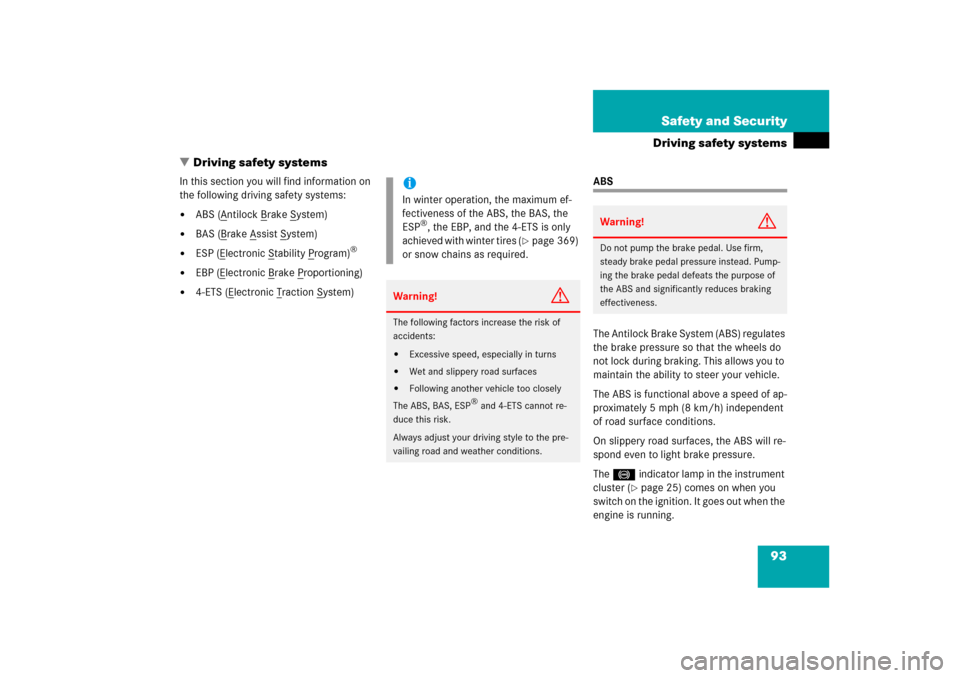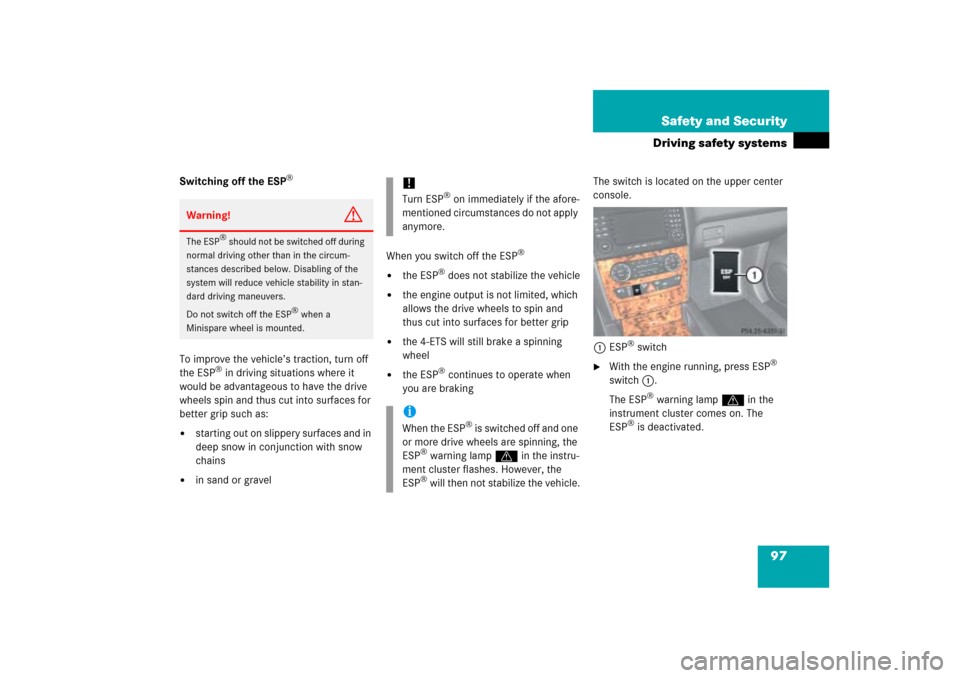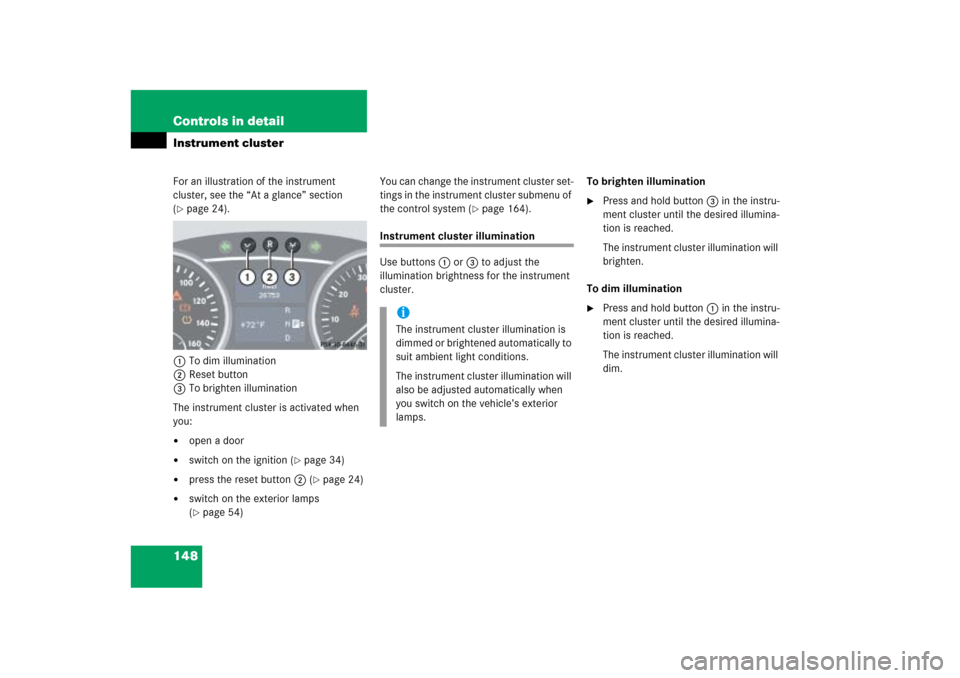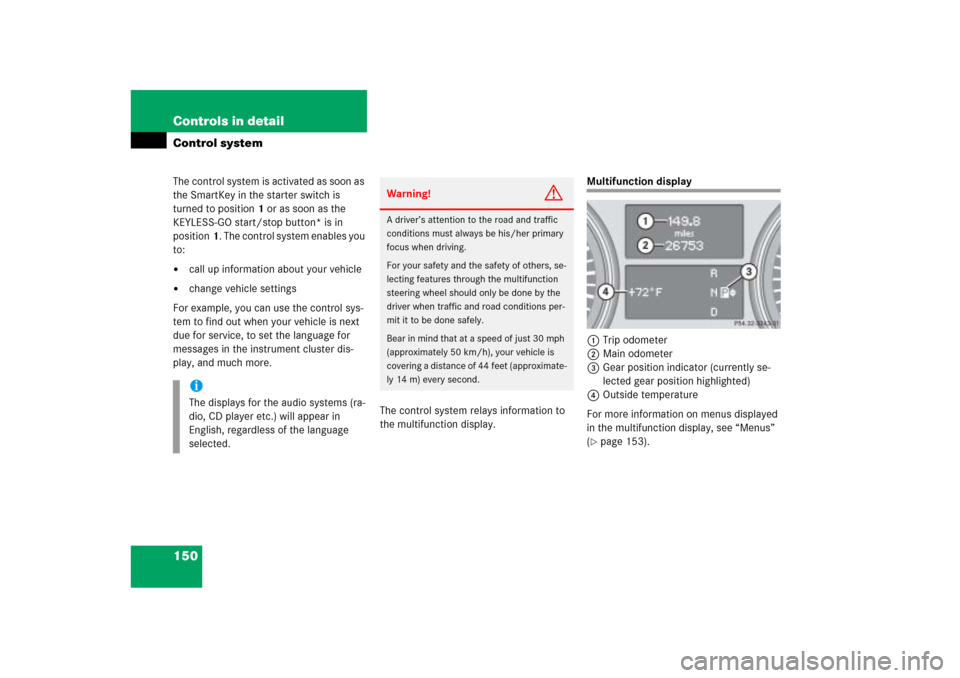Page 94 of 539

93 Safety and Security
Driving safety systems
�Driving safety systems
In this section you will find information on
the following driving safety systems:�
ABS (A
ntilock B
rake S
ystem)
�
BAS (B
rake A
ssist S
ystem)
�
ESP (E
lectronic S
tability P
rogram)
®
�
EBP (E
lectronic B
rake P
roportioning)
�
4-ETS (E
lectronic T
raction S
ystem)
ABS
The Antilock Brake System (ABS) regulates
the brake pressure so that the wheels do
not lock during braking. This allows you to
maintain the ability to steer your vehicle.
The ABS is functional above a speed of ap-
proximately 5 mph (8 km/h) independent
of road surface conditions.
On slippery road surfaces, the ABS will re-
spond even to light brake pressure.
The -indicator lamp in the instrument
cluster (
�page 25) comes on when you
switch on the ignition. It goes out when the
engine is running.
iIn winter operation, the maximum ef-
fectiveness of the ABS, the BAS, the
ESP
®, the EBP, and the 4-ETS is only
achieved with winter tires (
�page 369)
or snow chains as required.
Warning!
G
The following factors increase the risk of
accidents:�
Excessive speed, especially in turns
�
Wet and slippery road surfaces
�
Following another vehicle too closely
The ABS, BAS, ESP
® and 4-ETS cannot re-
duce this risk.
Always adjust your driving style to the pre-
vailing road and weather conditions.
Warning!
G
Do not pump the brake pedal. Use firm,
steady brake pedal pressure instead. Pump-
ing the brake pedal defeats the purpose of
the ABS and significantly reduces braking
effectiveness.
Page 98 of 539

97 Safety and Security
Driving safety systems
Switching off the ESP
®
To improve the vehicle’s traction, turn off
the ESP
® in driving situations where it
would be advantageous to have the drive
wheels spin and thus cut into surfaces for
better grip such as:
�
starting out on slippery surfaces and in
deep snow in conjunction with snow
chains
�
in sand or gravelWhen you switch off the ESP
®
�
the ESP
® does not stabilize the vehicle
�
the engine output is not limited, which
allows the drive wheels to spin and
thus cut into surfaces for better grip
�
the 4-ETS will still brake a spinning
wheel
�
the ESP
® continues to operate when
you are brakingThe switch is located on the upper center
console.
1ESP
® switch
�
With the engine running, press ESP
®
switch1.
The ESP
®warning lampv in the
instrument cluster comes on. The
ESP
® is deactivated.
Warning!
G
The ESP
® should not be switched off during
normal driving other than in the circum-
stances described below. Disabling of the
system will reduce vehicle stability in stan-
dard driving maneuvers.
Do not switch off the ESP
® when a
Minispare wheel is mounted.
!Turn ESP
® on immediately if the afore-
mentioned circumstances do not apply
anymore.
iWhen the ESP
® is switched off and one
or more drive wheels are spinning, the
ESP
® warning lampv in the instru-
ment cluster flashes. However, the
ESP® will then not stabilize the vehicle.
Page 99 of 539

98 Safety and SecurityDriving safety systems
Switching on the ESP
®
�
Press ESP
® switch1.
The ESP
® warning lampv in the
instrument cluster goes out.
You are now again in normal driving
mode.
For more information, see “Practical hints”
(
�page 381).
Off-road – ESP
®
With the off-road driving program switched
on (
�page 248), the ESP
® designed for
off-road use is automatically activated. At
speeds below 27 mph (45 km/h), the
ESP
® assists in over-/understeering, thus
improving vehicle traction.
EBP
The EBP enhances braking effectiveness
by allowing the rear brakes to supply a
greater proportion of the braking effort
without a loss of vehicle stability.4-ETS
The 4-Electronic Traction System (4-ETS)
improves vehicle’s ability to utilize avail-
able traction, especially under slippery
road conditions. The brakes are applied to
the spinning wheel and power is trans-
ferred to the wheel(s) with traction.
The ESP
® warning lampv in the instru-
ment cluster, starts to flash at any vehicle
speed, as soon as a tire loses traction and
the wheel begins to spin.
Warning!
G
When the ESP
® warning lampv is
illuminated continuously, the ESP
® is
switched off.
Adapt your speed and driving to the prevail-
ing road conditions and to the non-operating
status of the ESP
®.
!Avoid spinning of a drive wheel for an
extended period of time with the ESP
®
switched off. This may cause serious
damage to the drivetrain which is not
covered by the Mercedes-Benz Limited
Warranty.
!Turn on the ESP
® immediately if the
aforementioned circumstances do not
apply anymore.
iIf conditions require, switch on
Off-road driving program*
(�page 248).
Page 106 of 539
105 Controls in detail
Locking and unlocking
Seats
Memory function*
Lighting
Instrument cluster
Control system
Automatic transmission
Transfer case
Good visibility
Climate control
3-zone automatic climate control*
Power windows
Power tilt/sliding sunroof*
Driving systems
Loading
Useful features
Page 144 of 539

143 Controls in detail
Lighting
�
Push the combination switch in
direction of arrow1 to switch on the
high beam.
The high beam headlamp indicator
lampA in the instrument cluster
comes on (
�page 24).
�
Pull the combination switch in direction
of arrow2 to its original position to
switch off the high beam.
The high beam headlamp indicator
lampA in the instrument cluster
goes out.
High beam flasher
�
Pull the combination switch briefly in
direction of arrow2.
Corner-illuminating front fog lamps*
The corner-illuminating front fog lamps im-
prove illumination of the road onto which
you are turning.
The corner-illuminating front fog lamps will
operate with the engine running and with�
the exterior lamp switch in
positionB (
�page 138)
or
�
the exterior lamp switch in
positionU (
�page 138)
or
�
the daytime running lamp mode
activated (
�page 140)Driving forward
Switching on corner-illuminating front
fog lamps
�
Depending on whether you are turning
left or right, switch on the left or right
turn signal (
�page 54).
The respective front fog lamp comes on
and illuminates the area in the direc-
tion into which you are turning.
iCorner-illuminating front fog lamps will
only come on in low ambient lighting
conditions.
The corner-illuminating front fog lamps
function is not available at a vehicle
speed above 25 mph (40 km/h).
iThe corner-illuminating front fog lamps
will come on automatically depending
on the steering angle, even if you did
not switch on either turn signal. If the
corner-illuminating front fog lamps
came on automatically, they will also
go out automatically depending on the
steering angle.
Page 149 of 539

148 Controls in detailInstrument clusterFor an illustration of the instrument
cluster, see the “At a glance” section
(�page 24).
1To dim illumination
2Reset button
3To brighten illumination
The instrument cluster is activated when
you:
�
open a door
�
switch on the ignition (
�page 34)
�
press the reset button2 (
�page 24)
�
switch on the exterior lamps
(�page 54)You can change the instrument cluster set-
tings in the instrument cluster submenu of
the control system (
�page 164).
Instrument cluster illumination
Use buttons1 or3 to adjust the
illumination brightness for the instrument
cluster.To brighten illumination
�
Press and hold button3 in the instru-
ment cluster until the desired illumina-
tion is reached.
The instrument cluster illumination will
brighten.
To dim illumination
�
Press and hold button1 in the instru-
ment cluster until the desired illumina-
tion is reached.
The instrument cluster illumination will
dim.
iThe instrument cluster illumination is
dimmed or brightened automatically to
suit ambient light conditions.
The instrument cluster illumination will
also be adjusted automatically when
you switch on the vehicle’s exterior
lamps.
Page 150 of 539

149 Controls in detail
Instrument cluster
Trip odometer
Make sure you are viewing the trip odome-
ter display (
�page 150).
�
If it is not displayed, press buttonè
orÿ on the multifunction steering
wheel (
�page 151) until the trip odom-
eter appears.
�
Press and hold the reset button on the
instrument cluster (
�page 148) until
the trip odometer is reset.
Tachometer
The red marking on the tachometer
(�page 24) denotes excessive engine
speed.To help protect the engine, the fuel supply
is interrupted if the engine is operated
within the red marking.
Outside temperature indicator
The outside temperature is displayed in
the multifunction display (
�page 150).The temperature sensor is located in the
front bumper area. Due to its location, the
sensor can be affected by road or engine
heat during idling or slow driving. This
means that the accuracy of the displayed
temperature can only be verified by com-
parison to a thermometer placed next to
the sensor, not by comparison to external
displays (e.g. bank signs etc.).
When moving the vehicle into colder ambi-
ent temperatures (e.g. when leaving your
garage), you will notice a delay before the
lower temperature is displayed.
A delay also occurs when ambient temper-
atures rise. This prevents inaccurate tem-
perature indications caused by heat
radiated from the engine during idling or
slow driving.
!Avoid driving at excessive engine
speeds, as it may result in serious en-
gine damage that is not covered by the
Mercedes-Benz Limited Warranty.
Warning!
G
The outside temperature indicator is not de-
s i g n e d t o s e r v e a s a n i c e - w a r n i n g d e v i c e a n d
is therefore unsuitable for that purpose.
Indicated temperatures just above the freez-
ing point do not guarantee that the road sur-
face is free of ice. The road may still be icy,
especially in wooded areas or on bridges.
Page 151 of 539

150 Controls in detailControl systemThe control system is activated as soon as
the SmartKey in the starter switch is
turned to position1 or as soon as the
KEYLESS-GO start/stop button* is in
position1. The control system enables you
to:�
call up information about your vehicle
�
change vehicle settings
For example, you can use the control sys-
tem to find out when your vehicle is next
due for service, to set the language for
messages in the instrument cluster dis-
play, and much more.
The control system relays information to
the multifunction display.
Multifunction display
1Trip odometer
2Main odometer
3Gear position indicator (currently se-
lected gear position highlighted)
4Outside temperature
For more information on menus displayed
in the multifunction display, see “Menus”
(�page 153).
iThe displays for the audio systems (ra-
dio, CD player etc.) will appear in
English, regardless of the language
selected.
Warning!
G
A driver’s attention to the road and traffic
conditions must always be his/her primary
focus when driving.
For your safety and the safety of others, se-
lecting features through the multifunction
steering wheel should only be done by the
driver when traffic and road conditions per-
mit it to be done safely.
Bear in mind that at a speed of just 30 mph
(approximately 50 km/h), your vehicle is
covering a distance of 44 feet (approximate-
ly 14 m) every second.